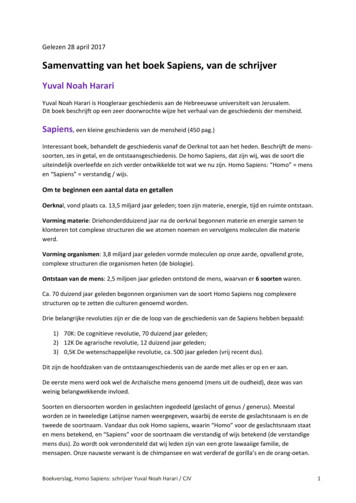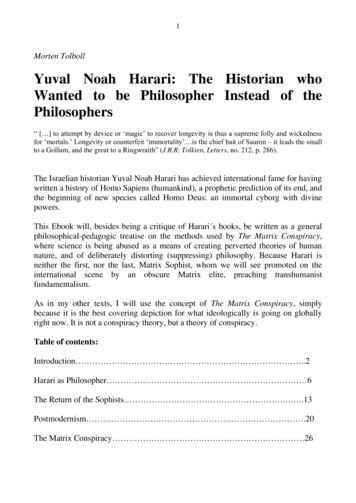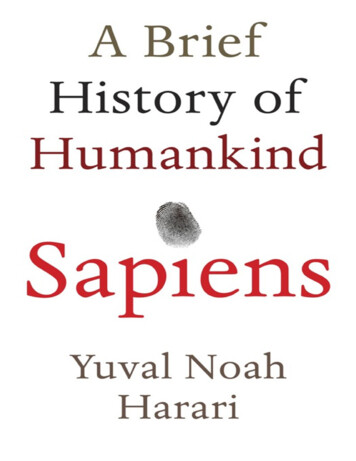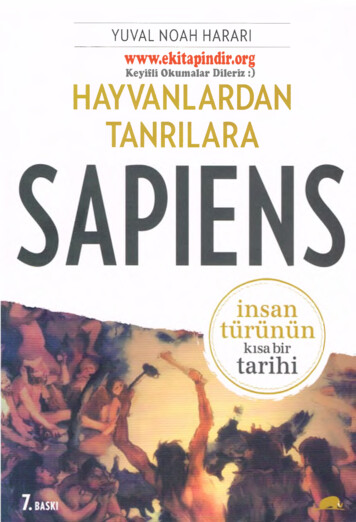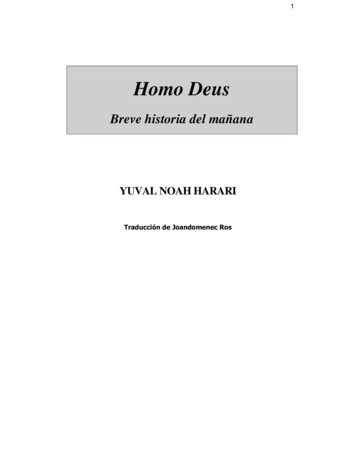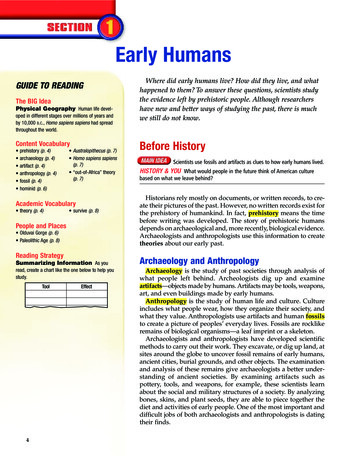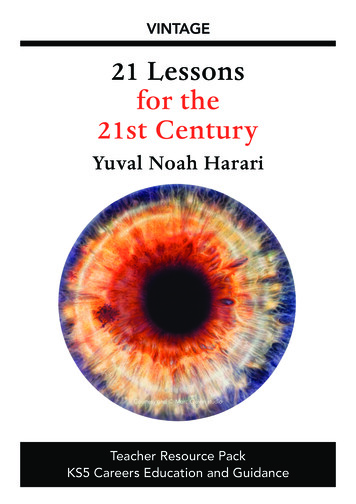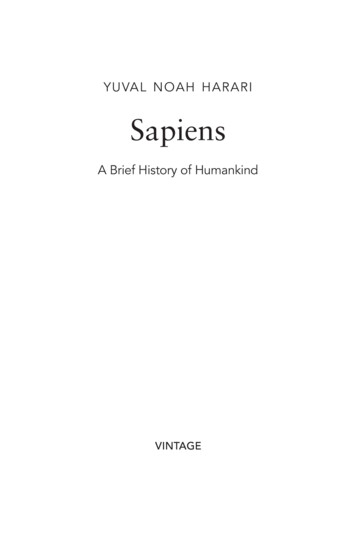
Transcription
YUVAL NOAH HARARISapiensA Brief History of HumankindA Brief History of Humankind
31Vintage20 Vauxhall Bridge Road,London SW1V 2SAVintage is part of the Penguin Random House group of companieswhose addresses can be found at global.penguinrandomhouse.com.Copyright Yuval Noah Harari 2011Translated by the author, with the help ofJohn Purcell and Haim WatzmanYuval Noah Harari has asserted his right to be identified as the author of thisWork in accordance with the Copyright, Designs and Patents Act 1988First published in Vintage in 2015First published in hardback by Harvill Secker in 2014First published in Hebrew in Israel in 2011 by Kinneret, Zmora-Bitan, Dvirpenguin.co.uk/vintageA CIP catalogue record for this book is available from the British LibraryISBN 9780099590088Typeset in Sabon by Palimpsest Book Production Limited,Falkirk, StirlingshirePicture Research by Caroline WoodMaps by Neil GowerPrinted and bound in Great Britain by Clays Ltd, Elcograf S.p.A.Penguin Random House is committed to a sustainable future forour business, our readers and our planet. This book is made fromForest Stewardship Council certified paper.
ContentsTimeline of HistoryixPart One The Cognitive Revolution1234An Animal of No SignificanceThe Tree of KnowledgeA Day in the Life of Adam and EveThe Flood3224570Part Two The Agricultural Revolution5678History’s Biggest FraudBuilding PyramidsMemory OverloadThere Is No Justice in History87110134149Part Three The Unification of Humankind910111213The Arrow of HistoryThe Scent of MoneyImperial VisionsThe Law of ReligionThe Secret of Success181193210233264Part Four The Scientific Revolution14151617TheTheTheTheDiscovery of IgnoranceMarriage of Science and EmpireCapitalist CreedWheels of Industry275307341374
18 A Permanent Revolution19 And They Lived Happily Ever After20 The End of Homo SapiensAfterword: The Animal that Becamea GodNotesAcknowledgementsImage CreditsIndex392421445465467481483485
Timeline of HistoryYears beforethe present13.58 billion Matter and energy appear. Beginning of physics. Atomsand molecules appear. Beginning of chemistry.4.5 billionFormation of planet Earth.3.8 billionEmergence of organisms. Beginning of biology.6 millionLast common grandmother of humans andchimpanzees.2.5 millionEvolutionevolveof the ingenusHomoAfrica.tools.First stone tools.HumansAfrica.Firstinstone2 millionHumans spread from Africa to Eurasia. Evolution ofdifferent human species.500,000Neanderthals evolve in Europe and the Middle East.300,000Daily usage of fire.200,000Homo sapiens evolves in East Africa.70,000The Cognitive Revolution. Emergence of fictivelanguage.Beginning of history. Sapiens spread out of Africa.45,000Sapiens settle Australia. Extinction of Australian megafauna.30,000Extinction of Neanderthals.16,000Sapiens settle America. Extinction of Americanmegafauna.ix
xSapiens13,000Extinction of Homo floresiensis. Homo sapiens the onlysurviving human species.12,000The Agricultural Revolution. Domestication of plantsand animals. Permanent settlements.5,000First kingdoms, script and money. Polytheistic religions.4,250First empire – the Akkadian Empire of Sargon.2,500Invention of coinage – a universal money.The Persian Empire – a universal political order ‘forthe benefit of all humans’.Buddhism in India – a universal truth ‘to liberate allbeings from suffering’.2,000Han Empire in China. Roman Empire in theMediterranean. Christianity.1,400Islam.500The Scientific Revolution. Humankind admits itsignorance and begins to acquire unprecedented power.Europeans begin to conquer America and the oceans.The entire planet becomes a single historical arena.The rise of capitalism.200The Industrial Revolution. Family and community arereplaced by state and market. Massive extinction ofplants and animals.The PresentHumans transcend the boundaries of planet Earth.Nuclear weapons threaten the survival of humankind.Organisms are increasingly shaped by intelligentdesign rather than natural selection.The FutureIntelligent design becomes the basic principle of life?Firstlife forms?Homonon-organicsapiens is replacedby superhumans?Homo sapiens is replaced by superhumans?
Part OneThe CognitiveRevolution1. A human handprint made about 30,000 yearsago, on the wall of the Chauvet-Pont-d’Arc Cave insouthern France. Somebody tried to say, ‘I was here!’
1An Animal ofNo SignificanceA B O U T 11 34. 5 B BI LI LL LI OI ONN YYEEAARRSS AAGGOO,, MMAATTT E R ,energy, time and space came into being in what is known as theBig Bang. The story of these fundamental features of our universeis called physics.About 300,000 years after their appearance, matter and energystarted to coalesce into complex structures, called atoms, which thencombined into molecules. The story of atoms, molecules and theirinteractions is called chemistry.4 billionAbout 3.8billion yearsyears ago,ago, onon aa planetplanet calledcalled Earth, certainmolecules combined to form particularly large and intricate structures called organisms. The story of organisms is called biology.About 70,000 years ago, organisms belonging to the species Homosapiens started to form even more elaborate structures called cultures.The subsequent development of these human cultures is calledhistory.Three important revolutions shaped the course of history: theCognitive Revolution kick-started history about 70,000 years ago.The Agricultural Revolution sped it up about 12,000 years ago. TheScientific Revolution, which got under way only 500 years ago, maywell end history and start something completely different. This booktells the story of how these three revolutions have affected humansand their fellow organisms.*3
4SapiensThere were humans long before there was history. Animals muchlike modern humans first appeared about 2.5 million years ago. Butfor countless generations they did not stand out from the myriadother organisms thatwithpopulatedwhich theythesharedplanet.their habitats.On a hike in East Africa 2 million years ago, you might wellhave encountered a familiar cast of human characters: anxiousmothers cuddling their babies and clutches of carefree childrenplaying in the mud; temperamental youths chafing against thedictates of society and weary elders who just wanted to be left inpeace; chest-thumping machos trying to impress the local beautyand wise old matriarchs who had already seen it all. These archaichumans loved, played, formed close friendships and competed forstatus and power – but so did chimpanzees, baboons and elephants.There was nothing special about humans. Nobody, least of all humansthemselves, had any inkling that their descendants would one daywalk on the moon, split the atom, fathom the genetic code andwrite history books. The most important thing to know aboutprehistoric humans is that they were insignificant animals with nomore impact on their environment than gorillas, fireflies or jellyfish.Biologists classify organisms into species. Animals are said tobelong to the same species if they tend to mate with each other,giving birth to fertile offspring. Horses and donkeys have a recentcommon ancestor and share many physical traits. But they showlittle sexual interest in one another. They will mate if induced todo so – but their offspring, called mules, are sterile. Mutations indonkey DNA can therefore never cross over to horses, or vice versa.The two types of animals are consequently considered two distinctspecies, moving along separate evolutionary paths. By contrast, abulldog and a spaniel may look very different, but they are membersof the same species, sharing the same DNA pool. They will happilymate and their puppies will grow up to pair off with other dogsand produce more puppies.Species that evolved from a common ancestor are bunched together
An Animal of No Signif icance5under the heading ‘genus’ (plural genera). Lions, tigers, leopards andjaguars are different species within the genus Panthera. Biologistslabel organisms with a two-part Latin name, genus followed byspecies. Lions, for example, are called Panthera leo, the species leo ofthe genus Panthera. Presumably, everyone reading this book is aHomo sapiens – the species sapiens (wise) of the genus Homo (man).Genera in their turn are grouped into families, such as the cats(lions, cheetahs, house cats), the dogs (wolves, foxes, jackals) and theelephants (elephants, mammoths, mastodons). All members of a familytrace their lineage back to a founding matriarch or patriarch. All cats,for example, from the smallest house kitten to the most ferocious lion,share a common feline ancestor who lived about 25 million years ago.Homo sapiens, too, belongs to a family. This banal fact used tobe one of history’s most closely guarded secrets. Homo sapiens longorphanwhohaspreferred to viewview imals,ananorphanbereftnofamily,family,lackingno cousins,– most importantly– no parents.Butofsiblingsandor cousins,and, most importantly,withoutthat’s justButnotthat’sthe case.it orcase.not,Likewe aremembersandparents.just Likenot theit ornot, weofarea largemembersparticularlynoisyfamily calledgreatcalledapes.theOurgreatnearestofa large eslivingincludechimpanzees,gorillas and gorillasorang-utans.The chimclosestrelativesinclude chimpanzees,and orang-utans.panzeesare the closest.Just6 millionago, ayearssingleago,femaleapeThechimpanzeesare theclosest.Just years6 milliona singlehad twoapedaughters.Onebecame theancestorof allfemalehad twodaughters.Onebecamethechimpanzees,ancestor of theallother is our ownchimpanzees,thegrandmother.other is our own grandmother.Skeletons in the ClosetHomo sapiens has kept hidden an even more disturbing secret. Notonly do we possess an abundance of uncivilised cousins, once upona time we had quite a few brothers and sisters as well. We are usedto thinking about ourselves as the only humans, because for the last10,000 years, our species has indeed been the only human speciesaround. Yet the real meaning of the word human is ‘an animalbelonging to thethe genusgenus Homo’,Homo’, andand therethereusedusedtotobebemanymanyotherother
6Sapiens2. Our siblings, accordingto speculative reconstructions(left to right):Homo rudolfensis (East Africa);Homo erectus (East Asia);and Homo neanderthalensis(Europe and western Asia).All are humans.species of this genus besides Homo sapiens. Moreover, as we shallsee in the last chapter of the book, in the not-so-distant future wemight again have to contend with non-sapiens humans. To clarifythis point, I will often use the term ‘Sapiens’ to denote membersof the species Homo sapiens, while reserving the term ‘human’ torefer to allall membersextant membersof theHomo.genus Homo.of the genusHumans first evolved in East Africa about 2.5 million years agofrom an earlier genus of apes called Australopithecus, which means‘Southern Ape’. About 2 million years ago, some of these archaic menand women left their homeland to journey through and settle vastareas of North Africa, Europe and Asia. Since survival in the snowyforests of northern Europe required different traits than those neededto stay alive in Indonesia’s steaming jungles, human populationsevolved in different directions. The result was several distinct species,to each of which scientists have assigned a pompous Latin name.Humans in Europe and western Asia evolved into Homo neander-
An Animal of No Signif icance7thalensis (‘Man from the Neander Valley’), popularly referred tosimply as ‘Neanderthals’. Neanderthals, bulkier and more muscularthan us Sapiens, were well adapted to the cold climate of Ice Agewestern Eurasia. The more eastern regions of Asia were populatedby Homo erectus, ‘Upright Man’, who survived there for close to 2million years, making it the most durable human species ever. Thisrecord is unlikely to be broken even by our own species. It is doubtfulwhether Homo sapiens will still be around a thousand years fromnow, so 2 million years is really out of our league.On the island of Java, in Indonesia, lived Homo soloensis, ‘Manfrom the Solo Valley’, who was suited to life in the tropics. Onanother Indonesian island – the small island of Flores – archaichumans underwent a process of dwarfing. Humans first reachedFlores when the sea level was exceptionally low, and the island waseasily accessible from the mainland. When the seas rose again, somepeople were trapped on the island, which was poor in resources.
8SapiensBig people, who need a lot of food, died first. Smaller fellowssurvived much better. Over the generations, the people of Floresbecame dwarves. This unique species, known by scientists as Homofloresiensis, reached a maximum height of only one metre and weighedno more than twenty-five kilograms. They were nevertheless able toproduce stone tools, and even managed occasionally to hunt downsome of the island’s elephants – though, to be fair, the elephantswere a dwarf species as well.In 2010 another lost sibling was rescued from oblivion, whenscientists excavating the Denisova Cave in Siberia discovered a fossilised finger bone. Genetic analysis proved that the finger belongedto a previously unknown human species, which was named Homodenisova. Who knows how many lost relatives of ours are waiting tobe discovered in other caves, on other islands, and in other climes?While these humans were evolving in Europe and Asia, evolutionin East Africa did not stop. The cradle of humanity continued tonurture numerous new species, such as Homo rudolfensis, ‘Man fromLake Rudolf’, Homo ergaster, ‘Working Man’, and eventually our ownspecies, which we’ve immodestly named Homo sapiens, ‘Wise Man’.The members of some of these species were massive and otherswere dwarves. Some were fearsome hunters and others meek plantgatherers. Some lived only on a single island, while many roamedover continents. But all of them belonged to the genus Homo. Theywere all human beings.It’s a common fallacy to envision these species as arranged in astraight line of descent, with Ergaster begetting Erectus, Erectusbegetting the Neanderthals, and the Neanderthals evolving into us.This linear model gives the mistaken impression that at any particular moment only one type of human inhabited the earth, andthat all earlier species were merely older models of ourselves. Thetruth is that from about 2 million years ago until around 10,000years ago, the world was home, at one and the same time, to severalhuman species.species. AndAnd why not? Today there are many species of foxes,bears:
An Animal of No Signif icance9brownandbears,blackbears, polarbears.agoThewasearthwasbearspigs.The bears,earth grizzlyof a hundredmillenniawalkedonceat least sixspeciesofofman.man.It’sIt’sourour currentcurrent exclusivity,byat walkedleast sixbydifferentspeciesnot that multi-species past, that is peculiar – and perhaps incriminating. As we will shortly see, we Sapiens have good reasons to repressthe memory of our siblings.The Cost of ThinkingDespite their many differences, all human species share severaldefining characteristics. Most notably, humans have extraordinarilylarge brains compared to other animals. Mammals weighing sixtykilograms have an average brain size of 200 cubic centimetres. Theearliest men and women, 2.5 million years ago, had brains of about600 cubic centimetres. Modern Sapiens sport a brain averaging1,200–1,400 cubic centimetres. Neanderthal brains were even bigger.That evolution should select for larger brains may seem to uslike, well, a no-brainer. We are so enamoured of our high intelligencethat we assume that when it comes to cerebral power, more mustbe better. But if that were the case, the feline family would alsohave produced cats who could do calculus and frogs would by nowhave launched their own space programme. Why are giant brainsso rare inin thetheanimalanimalkingdom?kingdom.The fact is that a jumbo brain is a jumbo drain on the body. It’snot easy to carry around, especially when encased inside a massiveskull. It’s even harder to fuel. In Homo sapiens, the brain accountsfor about 2–3 per cent of total body weight, but it consumes 25 percent of the body’s energy when the body is at rest. By comparison,the brains of other apes require only 8 per cent of rest-time energy.Archaic humans paid for their large brains in two ways. Firstly, theyspent more time in search of food. Secondly, their muscles atrophied.Like a government diverting money from defence to education,humans diverted energy from biceps to neurons. It’s hardly a
10Sapiensforegone conclusion that this is a good strategy for survival on thesavannah. A chimpanzee can’t win an argument with a Homo sapiens,but the ape can rip the man apart like a rag doll.Today our big brains pay off nicely, because we can produce carsand guns that enable us to move much faster than chimps, andshoot them from a safe distance instead of wrestling. But cars andguns are a recent phenomenon. For more than 2 million years,human neural networks kept growing and growing, but apart fromsome flint knives and pointed sticks, humans had precious little toshow for it. What then drove forward the evolution of the massivehuman brain during those 2 million years? Frankly, we don’t know.Another singular human trait is that we walk upright on twolegs. Standing up, it’s easier to scan the savannah for game or enemies,and arms that are unnecessary for locomotion are freed for otherpurposes, like throwing stones or signalling. The more things thesehands could do, the more successful their owners were, so evolutionary pressure brought about an increasing concentration of nervesand finely tuned muscles in the palms and fingers. As a result,humans can perform very intricate tasks with their hands. In particular, they can produce and use sophisticated tools. The firstevidence for tool production dates from about 2.5 million years ago,and the manufacture and use of tools are the criteria by whicharchaeologists recognise ancient humans.Yet walking upright has its downside. The skeleton of our primateancestors developed for millions of years to support a creature thatwalked on all fours and had a relatively small head. Adjusting toan upright position was quite a challenge, especially when the scaffolding had to support an extra-large cranium. Humankind paidfor its lofty vision and industrious hands with backaches and stiffnecks.Women paid extra. An upright gait required narrower hips,constricting the birth canal – and this just when babies’ heads weregetting bigger and bigger. Death in childbirth became a major hazard
An Animal of No Signif icance11for human females. Women who gave birth earlier, when the infant’sbrain and head were still relatively small and supple, fared betterand lived to have more children. Natural selection consequentlyfavoured earlier births. And, indeed, compared to other animals,humans are born prematurely, when many of their vital systems arestill underdeveloped. A colt can trot shortly after birth; a kittenleaves its mother to forage on its own when it is just a few weeksold. Human babies are helpless, dependent for many years on theirelders for sustenance, protection and education.This fact has contributed greatly both to humankind’s extraordinary social abilities and to its unique social problems. Lone motherscould hardly forage enough food for their offspring and themselveswith needy children in tow. Raising children required constant helpfrom other family members and neighbours. It takes a tribe to raisea human. Evolution thus favoured those capable of forming strongsocial ties. In addition, since humans are born underdeveloped, theycan be educated and socialised to a far greater extent than any otheranimal. Most mammals emerge from the womb like glazed earthenware emerging from a kiln – any attempt at remoulding will onlyscratch or break them. Humans emerge from the womb like moltenglass from a furnace. They can be spun, stretched and shaped witha surprising degree of freedom. This is why today we can educateour children to become Christian or Buddhist, capitalist or socialist,warlike or peace-loving.We assume that a large brain, the use of tools, superior learningabilities and complex social structures are huge advantages. It seemsself-evident that these have made humankind the most powerfulanimal on earth. But humans enjoyed all of these advantages for afull 2 million years during which they remained weak and marginalcreatures. Thus humans who lived a million years ago, despite theirbig brains and sharp stone tools, dwelt in constant fear of predators,rarely hunted large game, and subsisted mainly by gathering plants,
12Sapiensscooping up insects, stalking small animals, and eating the carrionleft behind by other more powerful carnivores.One of the most common uses of early stone tools was to crackopen bones in order to get to the marrow. Some researchers believethis was our original niche. Just as woodpeckers specialise inextracting insects from the trunks of trees, the first humans specialised in extracting marrow from bones. Why marrow? Well, supposeyou observe a pride of lions take down and devour a giraffe. Youwait patiently until they’re done. But it’s still not your turn becausefirst the hyenas and jackals – and you don’t dare interfere withthem – scavenge the leftovers. Only then would you and your banddare approach the carcass, look cautiously left and right – and diginto the edible tissue that remained.This is a key to understanding our history and psychology. GenusHomo’s position in the food chain was, until quite recently, solidlyin the middle. For millions of years, humans hunted smaller creaturesand gathered what they could, all the while being hunted by largerpredators. It was only 400,000 years ago that several species of manbegan to hunt large game on a regular basis, and only in the last100,000 years – with the rise of Homo sapiens – that man jumpedto the top of the food chain.That spectacular leap from the middle to the top had enormousconsequences. Other animals at the top of the pyramid, such aslions and sharks, evolved into that position very gradually, overmillions of years. This enabled the ecosystem to develop checks andbalances that prevent lions and sharks from wreaking too muchhavoc. As lions became deadlier, so gazelles evolved to run faster,hyenas to cooperate better, and rhinoceroses to be more badtempered. In contrast, humankind ascended to the top so quicklythat the ecosystem was not given time to adjust. Moreover, humansthemselves failed to adjust. Most top predators of the planet aremajestic creatures. Millions of years of dominion have filled themwith self-confidence. Sapiens by contrast is more like a banana-
An Animal of No Signif icance13republic dictator. Having so recently been one of the underdogs ofthe savannah, we are full of fears and anxieties over our position,which makes us doubly cruel and dangerous. Many historical calamities, from deadly wars to ecological catastrophes, have resulted fromthis over-hasty jump.A Race of CooksA significant step on the way to the top was the domestication offire. Some human species may have made occasional use of fire asearly as 800,000 years ago. By about 300,000 years ago, Homo erectus,Neanderthals and the forefathers of Homo sapiens were using fire ona daily basis. Humans now had a dependable source of light andwarmth, and a deadly weapon against prowling lions. Not longafterwards, humans may even have started deliberately to torch theirneighbourhoods. A carefully managed fire could turn impassablebarren thickets into prime grasslands teeming with game. In addition,once the fire died down, Stone Age entrepreneurs could walk throughthe smoking remains and harvest charcoaled animals, nuts and tubers.But the best thing fire did was cook. Foods that humans cannotdigest in their natural forms – such as wheat, rice and potatoes –became staples of our diet thanks to cooking. Fire not only changedfood’s chemistry, it changed its biology as well. Cooking killed germsand parasites that infested food. Humans also had a far easier timechewing and digesting old favourites such as fruits, nuts, insectsand carrion if they were cooked. Whereas chimpanzees spend fivehours a day chewing raw food, a single hour suffices for peopleeating cooked food.The advent of cooking enabled humans to eat more kinds offood, to devote less time to eating, and to make do with smallerteeth and shorter intestines. Some scholars believe there is a directlink between the advent of cooking, the shortening of the human
14Sapiensintestinal track, and the growth of the human brain. Since longintestines and large brains are both massive energy consumers, it’shard to have both. By shortening the intestines and decreasing theirenergy consumption, cooking inadvertently opened the way to thejumbo brains of Neanderthals and Sapiens.1Fire also opened the first significant gulf between man and theother animals. The power of almost all animals depends on theirbodies: the strength of their muscles, the size of their teeth, thebreadth of their wings. Though they may harness winds and currents,they are unable to control these natural forces, and are alwaysconstrained by their physical design. Eagles, for example, identifythermal columns rising from the ground, spread their giant wingsand allow the hot air to lift them upwards. Yet eagles cannot controlthe location of the columns, and their maximum carrying capacityis strictly proportional to their wingspan.When humans domesticated fire, they gained control of anobedient and potentially limitless force. Unlike eagles, humans couldchoose when and where to ignite a flame, and they were able toexploit fire for any number of tasks. Most importantly, the powerof fire was not limited by the form, structure or strength of thehuman body. A single woman with a flint or fire stick could burndown an entire forest in a matter of hours. The domestication offire was a sign of things to come.Our Brothers’ KeepersDespite the benefits of fire, 150,000 years ago humans were stillmarginal creatures. They could now scare away lions, warm themselves during cold nights, and burn down the occasional forest. Yetcounting all species together, there were still no more than perhapsa million humans living between the Indonesian archipelago andthe Iberian peninsula, a mere blip on the ecological radar.
An Animal of No Signif icance15Our own species, Homo sapiens, was already present on the worldstage, but so far it was just minding its own business in a cornerof Africa. We don’t know exactly where and when animals that canbe classified as Homo sapiens first evolved from some earlier type ofhumans, but most scientists agree that by 150,000 years ago, EastAfrica was populated by Sapiens that looked just like us. If one ofthem turned up in a modern morgue, the local pathologist wouldnotice nothing peculiar. Thanks to the blessings of fire, they hadsmaller teeth and jaws than their ancestors, whereas they had massivebrains, equal in size to ours.Scientists also agree that about 70,000 years ago, Sapiens fromEast Africa spread into the Arabian peninsula, and from there theyquickly overran the entire Eurasian landmass.When Homo sapiens landed in Arabia, most of Eurasia was alreadysettled by other humans. What happened to them? There are twoconflicting theories. The ‘Interbreeding Theory’ tells a story of attraction, sex and mingling. As the African immigrants spread aroundthe world, they bred with other human populations, and peopletoday are the outcome of this interbreeding.For example, when Sapiens reached the Middle East and Europe,they encountered the Neanderthals. These humans were moremuscular than Sapiens, had larger brains, and were better adaptedto cold climes. They used tools and fire, were good hunters, andapparently took care of their sick and infirm. (Archaeologists havediscovered the bones of Neanderthals who lived for many years withsevere physical handicaps, evidence that they were cared for by theirrelatives.) Neanderthals are often depicted in caricatures as thearchetypical brutish and stupid ‘cave people’, but recent evidencehas changed their image.According to the Interbreeding Theory, when Sapiens spread intoNeanderthal lands, Sapiens bred with Neanderthals until the twopopulations merged. If this is the case, then today’s Eurasians are notpure Sapiens. They are a mixture of Sapiens and Neanderthals.
16SapiensSimilarly, when Sapiens reached East Asia, they interbred with thelocal Erectus, so the Chinese and Koreans are a mixture of Sapiensand Erectus.called thethe ‘Replacement‘Replacement Theory’,Theory’ tells a veryThe opposing view, calleddifferent story – one of incompatibility, revulsion, and perhapseven genocide. According to this theory, Sapiens and other humanshad different anatomies, and most likely different mating habitsand even body odours. They would have had little sexual interestin one another. And even if a Neanderthal Romeo and a SapiensJuliet fell in love, they could not produce fertile children, becausethe genetic gulf separating the two populations was alreadyunbridgeable. The two populations remained completely distinct,and when the Neanderthals died out, or were killed off, their genesdied with them. According to this view, Sapiens replaced all theprevious human populations without merging with them. If thatis the case, the lineages of all contemporary humans can be tracedback, exclusively, to East Africa, 70,000 years ago. We are all ‘pureSapiens’.Map 1. Homo sapiens conquers the globe.
An Animal of No Signif icance17A lot hinges on this debate. From an evolutionary perspective,70,000 years is a relatively short interval. If the Replacement Theoryis correct, all living humans have roughly the same genetic baggage,and racial distinctions among them are negligible. But if theInterbreeding Theory is right, there might well be genetic differen
Homo sapiens - the species sapiens (wise) of the genus Homo (man). Genera in their turn are grouped into families, such as the cats (lions, cheetahs, house cats), the dogs (wolves, foxes, jackals) and the elephants (elephants, mammoths, mastodons). All members of a family trace their lineage back to a founding matriarch or patriarch. All cats,
